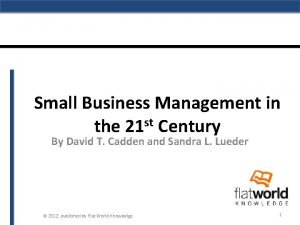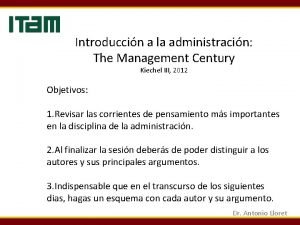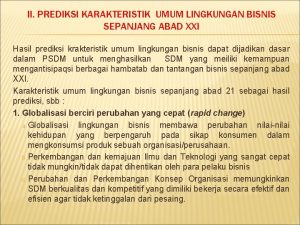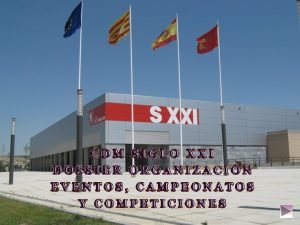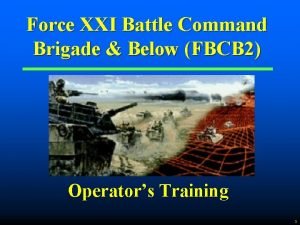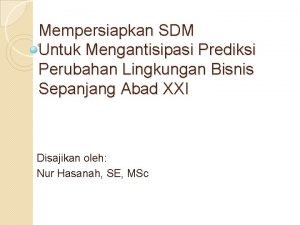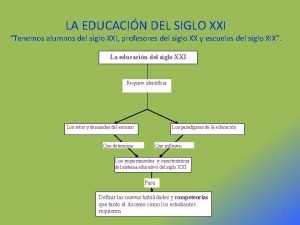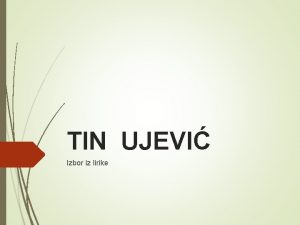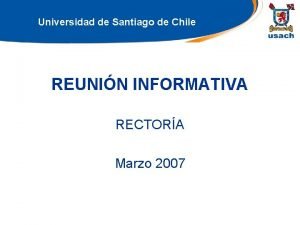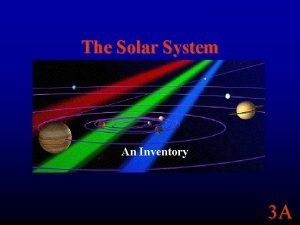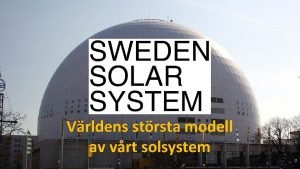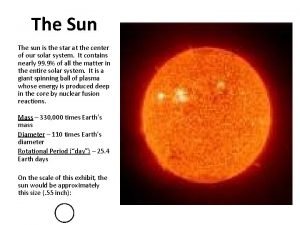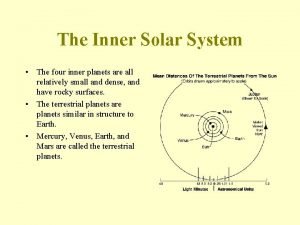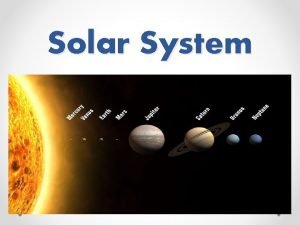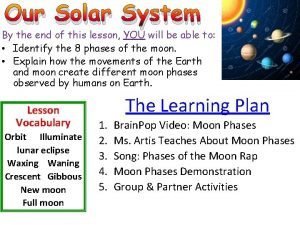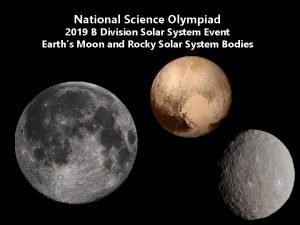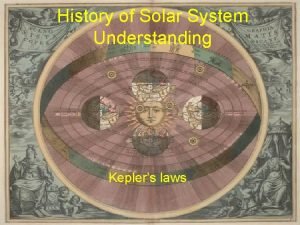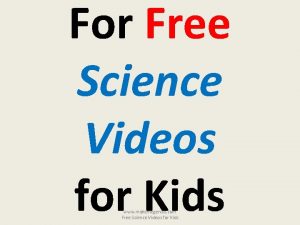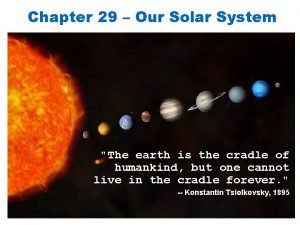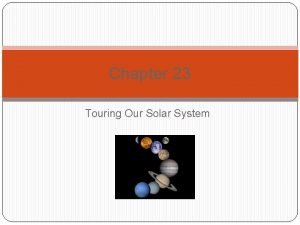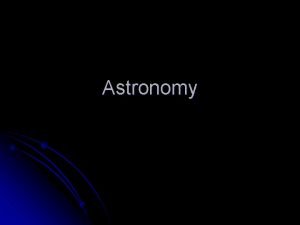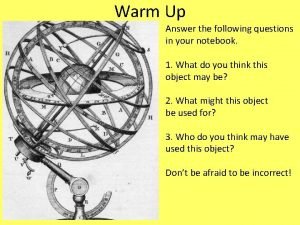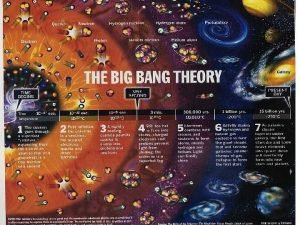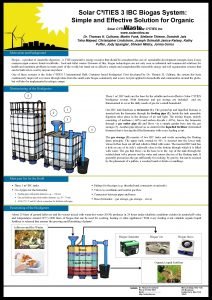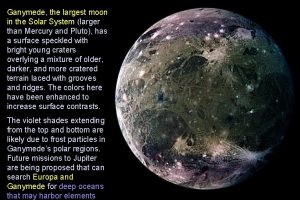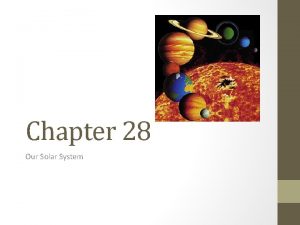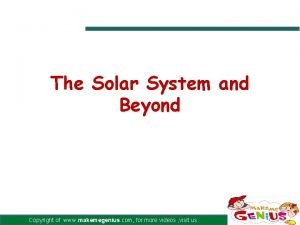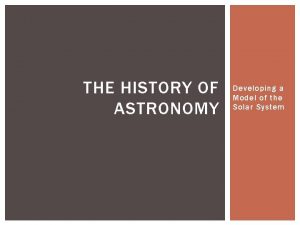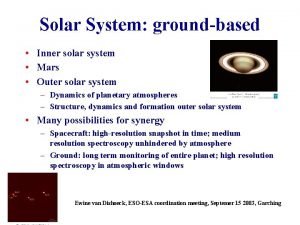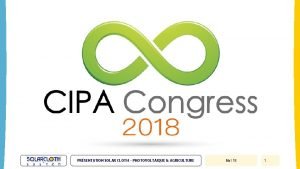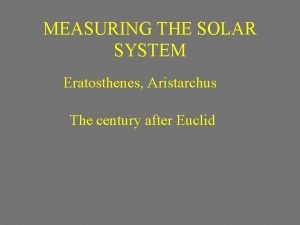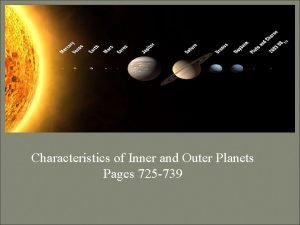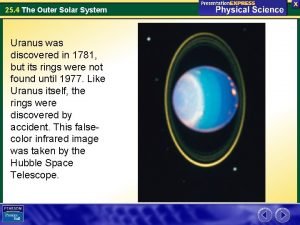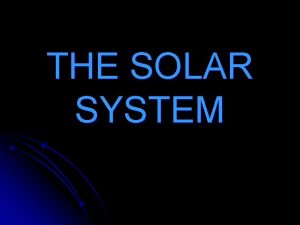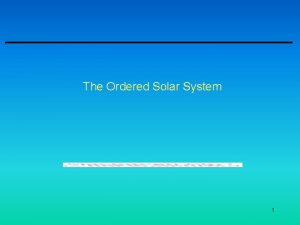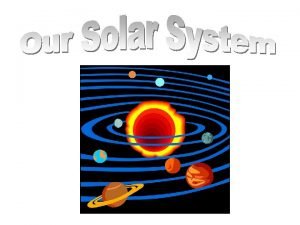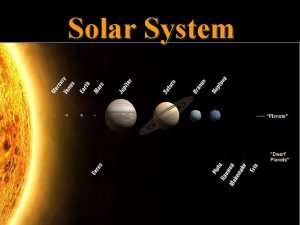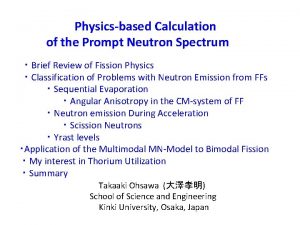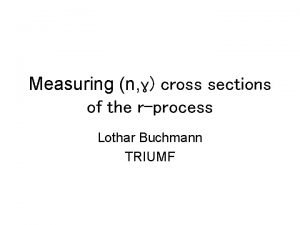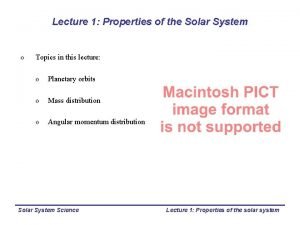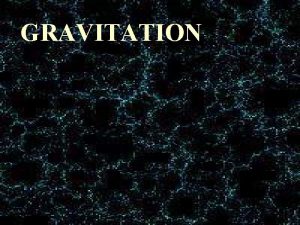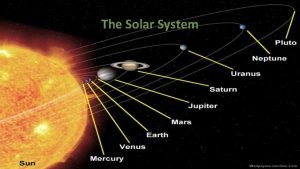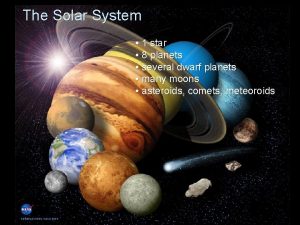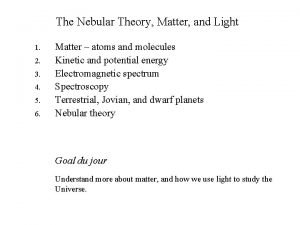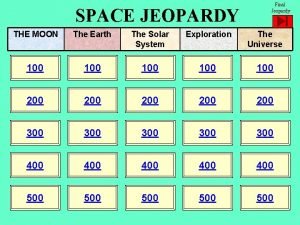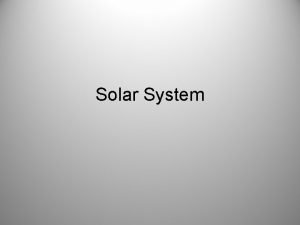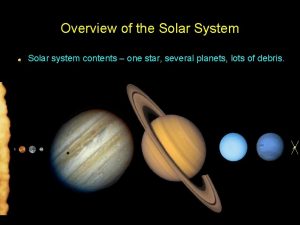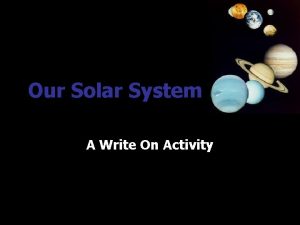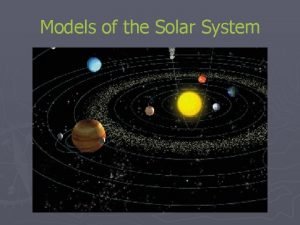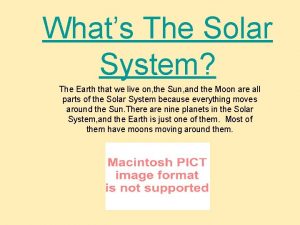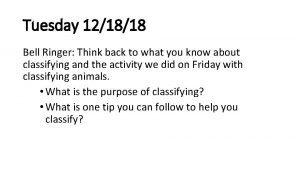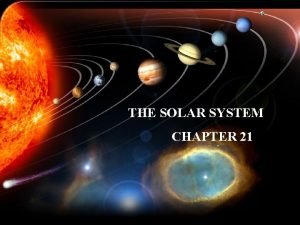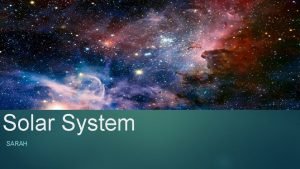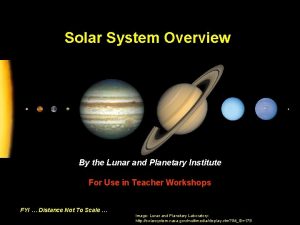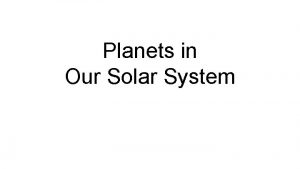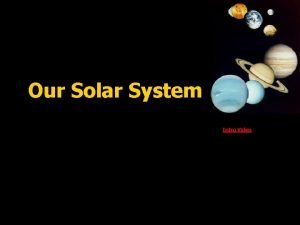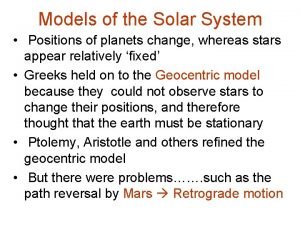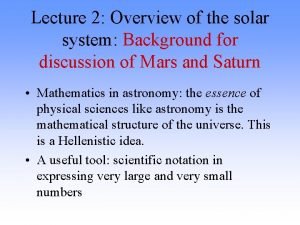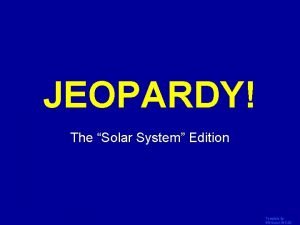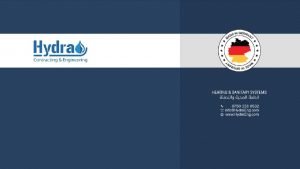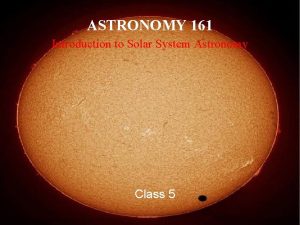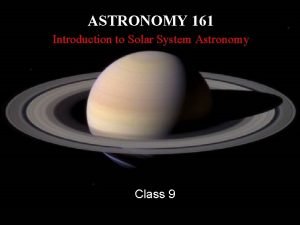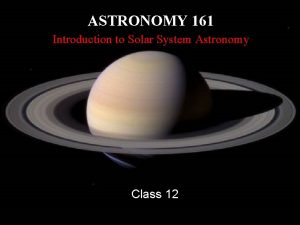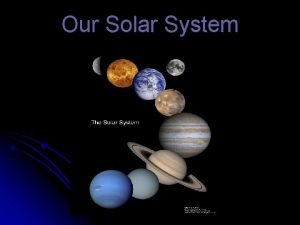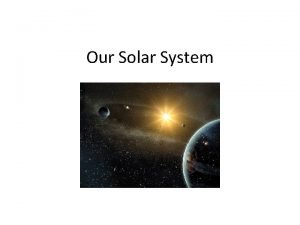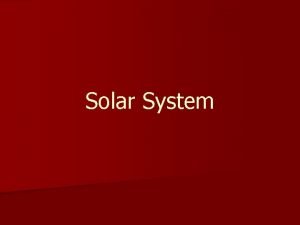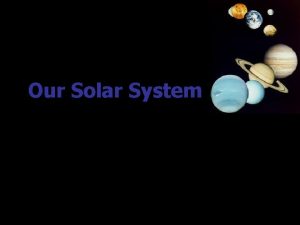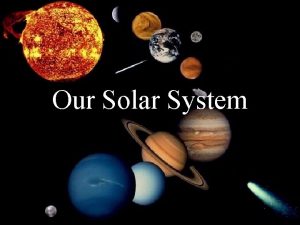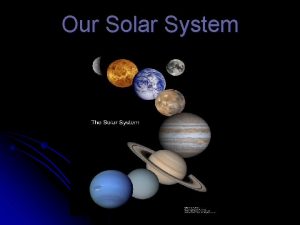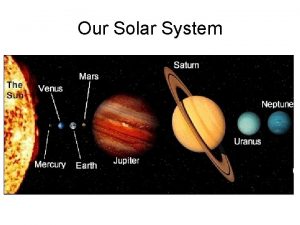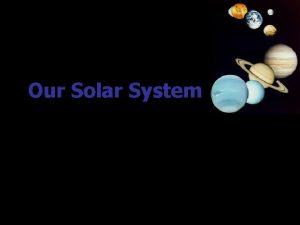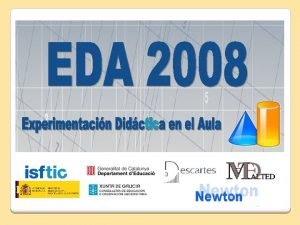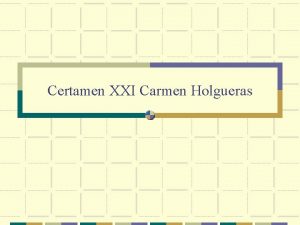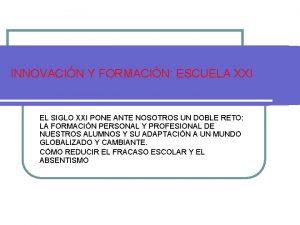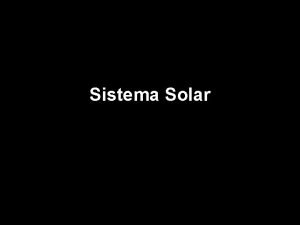THE XXI CENTURY ORGANIZATION Solar Management System the


































![Example of iteration of the Mandelbrot Fractal Formula: z(n+1) = [z(n)]2 + c Subsequent Example of iteration of the Mandelbrot Fractal Formula: z(n+1) = [z(n)]2 + c Subsequent](https://slidetodoc.com/presentation_image_h/7b99696f1b450fa0664957a705526a8a/image-35.jpg)










































































- Slides: 109

THE XXI CENTURY ORGANIZATION Solar Management System - the Fractal Organization in Practice Wojtek Luciejewski Warszawa, Osnabrück, Poznań, Ostercappeln (2001 – 2010)

Several years ago, when I published the first time in Internet "Primum non Prodigere" I foresaw the necessity of wider look at organization of XXI Century and inclusion of the nature examples (e. g. , new knowledge about Fractals). The present practice is proving this thesis. The acceleration of changes, which complicate our lives more and more, is shown on the next picture.


Is Organization a Machine? The central most aspect of the scientific foundation upon which Taylor built his theory of management was a metaphor popularized by the 17 th century French philosopher and mathematician Rene Descartes who looked at his world as a "clockwork universe. „ Taylor, as a devout Cartesian and as the best of his contemporaries, thus instilled in the mindsets of Western management the powerful and recalcitrant image of the machine.

Is Organization a Machine? The idea has become entrenched that the organizations we're supposed to be managing are physical instruments of production that humans engineered in the first place and are now being "re-engineered" in a misguided effort to solve their problems. The term alone attests to the depth to which mechanistic thinking has become embedded in our corporate psyches.

Is Organization a Machine? The robustness and endurance of the machine as the predominant metaphor of 20 th century management practice is nothing short of amazing given the mounting evidence that it simply does not work.

„Machine” organization still in good shape „We are products of the culture that we grew up in. When we live in machine organizations, we become part of them. Our organizations are not human or natural. They are machines. Machines are not designed to learn or accept feedback. They are inherently not responsive. When we are in them we treat each other like parts or things…. Some of us are so encultured by the old that we simply cannot imagine, or see, the reality of the new”.

„Machine” organization still in good shape Our operational culture has a series of rules, incentives and punishments that reinforce the old metaphor. It is not easy for anyone inside a traditional organization to make the changes to the new metaphor as all these forces will come into play against them.

„Machine” organization still in good shape All the rules of the old culture are based on the assumptions that the most important activity is control. The extension of this assumption is that if only we tried hard enough, we could control everything. This illusion seemed to work when we did not operate in a global society…. . As we talk about being more responsive, more customer-focused and more flexible, let’s look at the real rules that govern most of our organizations. They work against these objectives. ” According to „What is wrong with our concept of organization? Shifting our organizational metaphor from Machine to Nature” by Rob Paterson

1850 1900 1950 James Womack – Lean Manufacturing, Lean Enterprise Eliahu Goldratt – Theory of Constraints Taichi Ohno, Shigeo Shingo – Just In Time, Toyota Production System, World Class Manufacturing Edwards Deming, Joseph Juran – Statistical Process Control, TQM Henry Ford – assembly lines, flow of production, strategy Framk Gilbreth – the follower of taylorism, studies of motions, the beginning of ergonomics Lilian Gilbreth – the use of film into studies of work, the humanitarianism Frederick Taylor – standardization of work, the conflict between employees contra management, studies of time norms Standards of technical drawings, tolerances, development of modern machines Eli Whitney – interchangeability of parts Development of Management Methodologies 2000

Some latest initiatives Lean Management, TOC – Theory of Constraints, BMS – Bionic Management System, HMS – Holonic Manufacturing System, Chaordic Organization, Fractal Enterprise, Network Economy.

Lean Management in short Lean Management proves to be the complete management methodology. It includes the basic idea (philosophy of efficient operation), systems of management and information as well as the set of tools for their construction.

Lean Management in short The outstanding advantage of Lean Management is, that it shows the direction for improvements provided by the definition of Value and Waste. Another distinctive advantage is the flexibility in operations resulting from the feedback mechanism incorporated into management system – Enterprise Kaizen (if properly implemented).

Lean Definitions Value – the potential delivered to the customer at the right time and for an appropriate prize, to be defined each time by the customer. Value is defined by the features of a product or service, their availability, cost and performance parameters. Waste – each single action which uses resources but does not create Value; or everything that increases the cost of a product without adding Value to it. Enterprise Kaizen – continuous improvement of all business activities.

Program Kaizen should be used to guide improvements (by announced contests and other initiatives) into more flexibility in production lines and shorter production cycles.

Weaknesses of Lean Management Companies which implement Lean Management very often suffer defeats. The reason seems to be the Japanese culture and its automotive roots. Western culture favor individualism and doesn’t endorse excessive rigor or genetic obedience. Lean Management tools are strongly oriented on highly mechanized processes and only to some extend can be used for service processes The trend of world economy indicates quite clearly, that manufacturing is loosing its significance for the benefit of service An attempt of an orthodox or forced implementation can only generate more damages then benefits. We shouldn’t however turn down Lean Management entirely. It is still the most comprehensive management philosophy and definitions of Value and Waste are universal.

Theory of Constraints is based on the premise that the rate of goal achievement is limited by at least one constraining process. Only by increasing flow through the constraint can overall throughput be increased. The five focusing steps aim to ensure ongoing improvement efforts are centered around the organization's constraints.

Theory of Constraints The steps are: 1. Identify the constraint (the resource or policy that prevents the organization from obtaining more of the goal) 2. Decide how to exploit the constraint (get the most capacity out of the constrained process) 3. Subordinate all other processes to above decision (align the whole system or organization to support the decision made above) 4. Elevate the constraint (make other major changes needed to break the constraint) 5. If, as a result of these steps, the constraint has moved, return to Step 1. Don't let inertia become the constraint.

Bionic Management System On basis of patterns of biological organisms the Japanese experts propose the bionic system in which be realized the features of natural pattern: • • • Spontaneity, Motility, Harmony.

Bionic Management System It is proposed to imitate the features of biological organisms: • • The integration of functional elements and the hierarchy, The organizing the information in DNA, carrier of genetic information, Use of natural intelligence, Dynamic structure and social harmony.

Holonic Manufacturing Systems (HMS) was first proposed as a new manufacturing paradigm at the beginning of 1990. In an HMS, key elements such as machines, work centers, plants, parts, products, persons, departments, or divisions have autonomous and cooperative properties.

Holonic Manufacturing System These elements are called "holons, " a word coined by combining "holos" (the whole) and "on" (a particle) following A. Koestler. In an HMS, each holon's activities are determined through the cooperation with other holons, as opposed to being determined by a centralized mechanism.

Holonic Manufacturing System Luckily for us this proposal was created for artificial organizational creatures such as fully automated production and in such case the use of an example of human behaviors makes sense. Because robots can be programmed only according to the better side the human being.

Chaordic Organization Dee Hock has defined the necessary characteristic of emerging organizations: • • Enduring in purpose and principle. Powered from the periphery, unified from the core. Exist to enable constituent parts. Equitably distribute power, rights, responsibilities, and rewards. Fluid webs of cooperation and competition. Cannot be managed; can only be led. Compatible with the human spirit and biosphere.

Chaordic Design Six Lenses onto Organization Purpose - A clear, commonly understood statement of that which identifies and binds the community together as worthy of pursuit. Principles - Clear, commonly understood statements of how Participants will conduct themselves in pursuit of Purpose. Participants -The members of the community necessary to its effective initiation and continuance – all relevant and affected parties.

Chaordic Design Six Lenses onto Organizational concept - Characterization of Participant relationships that all can trust to be just, equitable and effective in achieving the Purpose in accord with the Principles. Constitution - Codification of Concept specifying rights, obligations and relationships of Participants, giving rise to the organization as a legal entity. Practices - Activities, products and services through which Participants pursue the organization’s Purpose and create value. Excerpts from “The Chaordic Organization: Out of Control and Into Order” by Dee Hock, Founder and CEO Emeritus of VISA International

Centralized control is archaic and self-limiting. Diversity and innovation thrive where power and information are highly distributed.

Competition and collaboration, freedom and governance, individuality and community are not irreconcilable opposites. The greatest benefit comes when they are harmoniously blended without losing the distinctive strength of each.

True communities are held together by ethics – not force and by the power of their shared beliefs, purposes, and identity.

Emerging Organizations Conventional Systems Emerging Systems • Closed • Open • Top-down and centrally oriented • Multi-centric and self-organizing • Corporate • Constitutional • Centralized • Decentralized • Departmentalized • Fractal • Controlling • Enabling Excerpts from “The Chaordic Organization: Out of Control and Into Order” by Dee Hock, Founder and CEO Emeritus of VISA International

Wacław Sierpiński (1882 – 1969) – prominent mathematician, studied also astronomy and philosophy. The ”Sierpinski Triangle” is a fractal named after him. He described it in 1915. This is one of the basic examples of self-similar sets, i. e. it is a mathematically generated pattern that can be reproducible at any magnification or reduction. Sierpinski Triangle

Geometrical Fractals 32

Fern's computer frond 33

Computer tree This fractal was created through the use of one only mathematical formula 34
![Example of iteration of the Mandelbrot Fractal Formula zn1 zn2 c Subsequent Example of iteration of the Mandelbrot Fractal Formula: z(n+1) = [z(n)]2 + c Subsequent](https://slidetodoc.com/presentation_image_h/7b99696f1b450fa0664957a705526a8a/image-35.jpg)
Example of iteration of the Mandelbrot Fractal Formula: z(n+1) = [z(n)]2 + c Subsequent approximations uncover different, but still similar features

Is the Nature fractal? Fractal geometry permits us to understand, how nature creates all its forms, which we can observe. The mountain formations, rivers, shores, the mammal's lung, vegetation and the blood circulation system, but and the surfaces of breakthroughs of metals as well as the growths and the falls of stock are fractals copying on many smaller levels of scale the main pattern. Fractals in effect behave like genetic algorithms permitting different species to reconstruct effectively essential functions. Let's take the example of a cloud - it constitute doubtless one the whole, but it is "full of holes" like a sponge, because it consists of countless quantity of microscopic drops of water and steam. It is separate the whole, but folded with many smaller the wholes, also separate. If "we will cut out" small piece of cloud, then we will receive something very similar to it. Development and the strength of computers permits us at present to see and better understand the law of evolution and what follows it laws of nature. 36

Fractal Enterprise Hans-Jürgen Warnecke advanced the hypothesis of fractal enterprises as the near future of development of organization, where independent teams co-operate in network on principle customer - supplier so inside as outside the organization. The leading thought for fractal organization is the creation (in range of its competence) of the self regulating organizational working groups. The superior computer informative and communication system should serve for tuning of the size of inputs and outputs.

Fractal Enterprise Fractal enterprise creates businesses within business, but also businessmen in enterprise. This corresponds better with the Western culture, which prefers the individuality. Prof. Warnecke did not propose practical solutions. We should remember however, that he wrote it in early 90 s, when the World really started experiencing the influence of Internet and Globalization.

Fractal Organization Fractals are the independently functioning units which objectives and expected productivity can be explicitly described. – Fractals are self-similar – each provides services. – Fractals are self-organizing. Fractals identify and formulate their objectives as well as the internal and external relations.

Fractal Organization Fractals reorganize (restructure) themselves, reemerge and fall into decomposition. – The overall system of objectives which results from the fractals objectives is no contradictory and must serve for achieving the objectives of the whole enterprise. – Fractals are connected into a network by an efficient system of information and communication. Fractals themselves determine the kind and scope of their access to the available data. – Fractals productivity is continuously measured and valued. Fractals have the attributes of the intelligent systems and react in an adaptive manner to every environment's influence.

New Rules for the New Economy 1)Embrace the Swarm. As power flows away from the center, the competitive advantage belongs to those who learn how to embrace decentralized points of control. 2) Increasing Returns. As the number of connections between people and things add up, the consequences of those connections multiply out even faster, so that initial successes aren’t self-limiting, but self -feeding. 3)Plentitude, Not Scarcity. As manufacturing techniques perfect the art of making copies plentiful, value is carried by abundance, rather than scarcity, inverting traditional business propositions. 4)Follow the Free. As resource scarcity gives way to abundance, generosity begets wealth. Following the free rehearses the inevitable fall of prices, and takes advantage of the only true scarcity: human attention. 5)Feed the Web First. As networks entangle all commerce, a firm’s primary focus shifts from maximizing the firm’s value to maximizing the network’s value. Unless the net survives, the firm perishes.

New Rules for the New Economy 6)Let Go at the Top. As innovation accelerates, abandoning the highly successful in order to escape from its eventual obsolescence becomes the most difficult and yet most essential task. 7)From Places to Spaces. As physical proximity (place) is replaced by multiple interactions with anything, anytime, anywhere (space), the opportunities for intermediaries, middlemen, and mid-size niches expand greatly. 8)No Harmony, All Flux. As turbulence and instability become the norm in business, the most effective survival stance is a constant but highly selective disruption that we call innovation. 9) Relationship Tech. As the soft trumps the hard, the most powerful technologies are those that enhance, amplify, extend, augment, distill, recall, expand, and develop soft relationships of all types. 10) Opportunities Before Efficiencies. As fortunes are made by training machines to be ever more efficient, there is yet far greater wealth to be had by unleashing the inefficient discovery and creation of new opportunities. Kevin Kelly, „New Rules for the New Economy, 10 Radical Strategies for a Connected World

Science accomplishments - new ”order” Logical-rational approach (determinism). Philosophers: • Platon (427 -347 B. C. ) • Aristotle (384 -322 B. C. ) • Rene Descartes (1596 -1650) • Pierre Laplace (1749 -1827) Mathematics and physics till the 19 th century Frederic Winslow Taylor – theory of industrial efficiency

Science accomplishments - new ”order” New Approach – Sustained Disequilibrium Giving up the thinking in ways of the linear extrapolation type or cause-and-effect chains • Jules Henri Poincaré (1854 -1912) • Theory of Relativity • Quantum Mechanics • Theory on Infinite Sets – Georg Cantor • Fractal geometry – Benoit Mandelbrot • Complex Adaptive Systems

1850 1900 1950 2000 Stephen William Hawking - British astrophysics, cosmologist, theoretician of physics Hans-Jürgen Warnecke – the German scholar, president of the Fraunhofer Institute, originator of fractal enterprise Peter F. Drucker - management expert, he was called the father of the founder of management or the pope of management Benoît B. Mandelbrot - recognized as the creator of fractals and fractal geometry John Boyd - the colonel of the air forces, creator of loop the OODA and theory of energy of shunter ability ( the Energy the Maneuverability) Dee Ward Hock – the creator the VISA International, first Chaordic organization Włodzimierz Sedlak – the Polish priest, creator of Polish school of bioelectronics and the electromagnetic theory of life Eduard Norton Lorenz – mathematician and meteorologist, creator of theory of chaos Albert Einstein - one of the best theoretical physicists, creator of special and general theory of relativity Wacław Sierpiński – doctor of philosophy, one of creators of Polish mathematical school, the constructor of the first fractal Charles F. Haanel – the father of personal development, author of The Master Key System Georg Cantor - – the creator of set theory; he unreeled conception of Absolute Infinity, which he identified with the God Jules Henri Poincaré – the precursor of theory of relativity and the chaos, creator of philosophical direction of conventionalism Ralph Waldo Emerson - philosopher, leader of the Transcendentalist movement Charles Darwin – one of the most important biologists of XIX age, author of theory evolution The way to Optimal Organization

Complex Adaptive Systems The subject of Complex Adaptive Systems has been studied for a long time in fields such as biology, cardiology, chemistry, computer science, demography, economics, mathematics, physics, game theory or meteorology.

Complex Adaptive Systems In the 70’s of the previous century, scientists from various fields discovered that different Complex Adaptive Systems share common features and may be effectively analyzed and examined as a group, despite their diverse origins.

Complex Adaptive Systems These systems include: biological species, cardiovascular systems, economy, human societies, neural systems, stock exchange or weather systems, to name just a few.

Complex Adaptive Systems Decentralized, competitive market – a classic example of the Complex Adaptive System - Adam Smith’s (1776) „invisible hand” manifests itself when the market participants reach the critical mass of self-organization.

The “Edge of Chaos” Where interesting things can happen Agricultural revolution Industrial revolution First Bifurcation Information/ knowledge revolution Second Bifurcation Mono-stability: evolution impossible Chaos Steady State Could apply to either a functional or programmatic design Opportunistic Regime “Edge of Chaos” Conducive to Self Organizing Systems Conducive to Complex Adaptive Systems Organizations capable of evolving and adapting Diagram courtesy of Dr. Linda Beckerman, Director of Systems Engineering, the ASSET Group, SAIC

Market – Sustained Disequilibrium? According to the neoclassical theory, the market naturally moves towards equilibrium by anticipating its participants’ logical behaviors. This kind of deductive thinking may be only justified for the certain market segments at a given time, because the current market have no one, but many equilibrium points.

Market – Sustained Disequilibrium? The observed contemporary complexity of problems enforce us to straying away from the deductive thinking. Inductive thinking – the market participants try to identify trends, interrelations and groups of phenomenon and then, through analogy to the past experiences, they try to anticipate the situation’s progress and search for optimal solutions. Process of co-evolution – system changes <–> the participants modify their behaviors what in consequence influences the changes of a system.

Market – Sustained Disequilibrium? In reality it is unreasonable to expect from the market participants the logical and rational behaviors. So different models of actions are created on the market and continuous evolution of the system is taking place. Market should be seen as the Complex Adaptive System and as such can not be considered to be the stable system (striving for equilibrium) but it is rather the vibrating equilibrium (periods of stability mixed with periods of chaos – sustained disequilibrium). According to „Organizacja na krawędzi chaosu”, Piotr Nestorowicz, 2001

Landscape of opportunities This landscape is changing itself with the function of time – the peaks get lower, disappear and new ones emerge. The practice shows that to be able to climb onto another peak it is necessary first to get down into the valley. Tim Mannon, the President of the Hewlett Packard Printer Department, once said: „The biggest single danger to our business is remaining for one year too long in the previous business which brought us success. ”

Be chaotic or death At first glance chaotic behavior appears to be the antithesis of organizational behavior, that necessitates order, regularity and predictability so as to ensure coordination, planning and control. A second look will remind us that variety and irregularity allow the resilience and creativity which are a necessity for learning, which is a condition to be able to survive.

The Goal - Survival on own terms Studies of human behavior reveal that the actions we undertake as individuals are closely related to survival, more importantly, survival on our own terms. Naturally, such a notion implies that we should be able to act relatively free or independent of any debilitating external influences--otherwise that very survival might be in jeopardy.

The Goal - Survival on own terms In viewing the instinct for survival in this manner we imply that a basic aim or goal, as individuals, is to improve our capacity for independent action. The degree to which we cooperate, or compete, with others is driven by the need to satisfy this basic goal. If we believe that it is not possible to satisfy it alone, without help from others, history shows us that we will agree to constraints upon our independent action in order to collectively pool skills and talents in the form of nations, corporations, labor unions, mafias, etc. --so that obstacles standing in the way of the basic goal can either be removed or overcome.

The Goal - Survival on own terms On the other hand, if the group cannot or does not attempt to overcome obstacles deemed important to many (or possibly any) of its individual members, the group must risk losing these alienated members. Under these circumstances, the alienated members may dissolve their relationship and remain independent, form a group of their own, or join another collective body in order to improve their capacity for independent action. John R. Boyd

O-O-D-A loop According to John Boyd, implicit (leaning on genetic heritage, cultural traditions and past experiences) communication accelerates undertaking decision and beginning of action. Observation Changing circumstances Implicit leadership and control Observations Information from outside Developing interaction with environment Orientation Decision Implicit leadership and control Cultural tradisions Genetic heritage New information Action Analysis And synthesis Past experiences Feedback Decision (Hypothesis) Action (Test) Developing interaction with environment Feedback Notice how the orientation shapes the observation, shapes the decision, shapes the action and in the response is shaped by the reaction and different phenomena coming to our view-finder of feeling or observation. Notice also, that the whole loop ( not only orientation) is the continuous, many-sided, implicit process of expectation, understanding, correlation and rejection. "This so as would be in the movie of slow-motion " - Boyd describing working inside loop OODA of the enemy. When you design, planning new strategy then keep the minimum speed of OODA loop, when you fight (with competition) provide for maximum speed.

Some wise quotations Any fool can make things bigger and more complex. It takes a touch of genius - and a lot of courage - to move in the opposite direction. -Albert Einstein Imagination is more important than knowledge. Knowledge is limited. Imagination encircles the world. -Albert Einstein Beauty of style and harmony and grace and good rhythm depend on simplicity. - Plato Making the simply complicated is commonplace; making the complicated simple, awesomely simple, that's creativity. - Charles Mingus Embrace simplicity. - Lao Tzu

New class divisions They who think and the others who accept their thoughts. They who know and the others, who agree to be only consumers of knowledge of those first.

Back to the roots Mankind looks for the way out from situation in which drove into. • Return to historical experiences and knowledge e. g. , The Acupuncture, Herbal Medicine, Folk Wisdoms. • • • Mankind comes back to the state of one unified civilization global village. Science and religions find common roots and agreement. One skill does not suffice even at present, we have to learn the whole life for adjust to very quick changes. The more and more stronger signals about inter-civilizations of co-operation, but also the frictions. Mankind tries to arrange the one`s puzzle from the beginning. This process is disturbed by the trials of clipping puzzles, and looking for skeleton-keys instead of using of suitable keys, made by many so in private life, professional as and in politics.

Learning from Nature Our brain is the ultimate example of a complex, decentralized organization. And because we (usually) behave coherently, smoothly integrating new circumstances as they arise, the brain is also the epitome of an adaptive organization, a learning organization, a sharedvision organization -- in short, the ideal modern company. There is no hierarchy, everything works perfectly without our conscious intervention.

Learning from Nature The sophisticated system of decentralized interdependence exhibited by termites invites a lesson on how to respond to emergencies, while the chemical-based communications among African ants helped officials at Southwest Airlines define their seating policy. Insects, birds, and fish variously demonstrate the plausibility and success of disorganization leading to self-organization and leaderless processes.

We have already started Then along comes the Internet, a communications medium that radically drops transaction and collaboration costs. Work can be organized on new project models, where the genius of human capital can be unleashed from its old command-control constraints. Employees can forge their own self-organized interconnections and form cross-functional teams capable of interacting as a global, real-time workforce. Loosening organizational hierarchies and giving more power to employees can lead to faster innovation, lower cost structures, greater agility, improved responsiveness to customers, and more authenticity and respect in the marketplace.

Fractals features in real life Jazz band has leader, plays composed work, but never plays it the same. Individual members' improvisations, in dependence from their skill and moods in given moment, are not only permissible, but outright waited (this playing solo takes over leadership in frames of its specialization). The members of team help the soloist to execute his task adjusting to him as well as to environment (atmosphere in the audience). Sport team has the aim - to reach competitive victory and to satisfy customers (own fans). Doing this the team has to observe the rules of game. The leader (in fact elected by team members) characterizes oneself with experience and suitable skills to this aim. The individual players' tasks change often in the course of duration of performance.

Fractals features in real life Marines team in modern war has appointed aim, designated resources, and when trying to foresee enemy's movements applies the technique of OODA loop and takes own decisions of operations. In the segment of time of 4 - 5 hours the participants of the trip from Warsaw to Poznan are taking a deadly game and in this way temporarily made up the team. We can observe then the self-similarity of their behaviors - overtaking themselves dangerously on two lines road as the third or fourth - they warn each other about radars and the selforganization is visible in retreating from road these freer (usually the small FIAT). Is winter and a lot of snow. Small car wanting to take the turn at side street he had to drive by strongly snow-covered tram tracks, so he hung on chassis. Other cars, wanting to take the same turn, blocked main street completely. Often, in such cases, unreasonable drivers blow the trumpet while sitting in warm cars. This time they went out and pushed out the unfortunate car on the even road and in this way removed traffic jam helping him and oneself.

Fractals features in real life Till March 2010 we survived 3 earthquakes (Haiti, Chile, Turkey). People got words of sympathy and the promises of help from the governments, but the true help was born itself. Men knew what they should do to help the others, leaders appeared spontaneously. In several cities in Europe (in Poland also) on primary road crossings all traffic signs were removed leaving only the rule of right side. The quantity of bumps and dangerous accidents fell down considerably. What it proves, that we need little controls to exist and to develop as communities.

Evolution in Biology and Economy Primates • Highly organized (fractal) • High flexibility • Optimal use of resources • Influence on ecology • Organic harmony of respective functions • Good structures and processes • Flexibility and moderate adaptability • Centralized flow of material and information Chaordic (Fractal) Enterprise Demand Flow Organization Vertebrate • High efficiency • Sluggish • Adjustment problems • Success only in small niche Multicellular organism • Low efficiency • Undemanding • Narrow range Unicellular organism Functional Organization Workshop Handicraft The best way to predict the future is to create it - Peter F. Drucker

Primates? Organizations (systems), even the best, will not achieve (produce) the success on their own. Only the knowledge of the people who manage, observe, study and improve these systems and their environment will make this possible. As long as there is still somebody to turn out the lights and leave the room filled with robots, organization will still be alive and the human factor will affect this organization in a decisive manner. The structure of modern organization should be in accordance with the development of primates and therefore promote a leadership based on knowledge, intelligence and skills – contrary to the „command control” type.

Henry Ford “One of the most noteworthy accomplishments in keeping the price of Ford products low is the gradual shortening of the production cycle. The longer an article is in the process of manufacture and the more it is moved about, the greater is it’s ultimate cost. ” - Henry Ford, 1926

The life wasn’t meant to be easy “There is nothing more difficult to plan, more doubtful of success, nor more dangerous to manage than the creation of a new system. For the initiator has the enmity of all who would profit by the preservation of the old system and the merely lukewarm defenders in those who would gain by the new one. ” - Machiavelli, 1513 Is your company rewarding the "firefighters", but not them who prevent problems?

Digital Business Effective business today is impossible without the application of computer technology. The speed of digital technology greatly (a few dozen times) shortens the distance between information and decision.

Digital Business Prior to application of the digital technology (e. g. computer management system), it is necessary to answer a few questions: • • How do you finance the company and its growth? How do you attract and retain more than your fair share of the best talents? How do you segment and serve your customers in the best and most cost-effective way? And how do you make the most of the competitive advantages afforded by speed in all of your business operations?

Humane organization We proved previously, that nature has fractal character, It was proved also already comparatively long ago, that the machine should not be example for organization, particularly in the era of globalization and the customer's market, Organization is as alive as its people and so has also its own personality, As long as the last man will not leave the room full with robots and switch off light (robots do not need it) as long he will have decisive influence on events - so favorably as negatively, If we want to exist and prosper in present time we should adapt the organization to nature and take example from it.

New paradigms Organization, the environment operates within and the market on which operates constitute all the Complex Adaptive Systems. Chaos has become a fixed component of our reality. In order to exist, people need to preserve a minimum order within chaos. The Lean philosophy of effective operation with its components (Waste, Value, Kaizen) may provide a sense of order.

New paradigms Given the constant lowering of the manufacturing cost, the main function of the organization (as well as its internal components) will finally focus on the services and their organizational attributes (e. g. cooperation with a client and its satisfaction). Components of the organization should be fractal in character (self-similarity, self-organization and vitality) and their partial objectives should satisfy the conditions of reaching the objectives of the organization (by respective measures). Fractals may become independent, so the organization may become virtual.

Solar Management System Fractal Organization in Practice

The aim of Solar Management System Building the basis for effective and highefficient, but simultaneously flexible and humane (for people) organization

Solaris Management System assumptions To manage these existing and future challenges we have to: Create and initiate the new system of management, which will be appropriate to the need of time. Give the citizenship to employees ( create community) which will make possible the reversal of pyramid of responsibility. Replace hierarchic dependences with relations Customer - Supplier, and quality and timing should be the measure of services (the best financially). Establish system of rewards about skill and usefulness for organization and not about position in hierarchy. Inform all workers, that all what we do is related to money (as profits as losses). Shorten persistently productive cycles to outdistance competition. Find system solution for the inevitable changeability of rhythm of production.

Solar Management System Organization is so alive as are its people and so, some change or improvement has to begin from them because, if they will not accept this, this change will not happen. Solar Management System: Gives people the chance to adapt to organization, using fully their ability and to permit them to organize their work, underlines strongly the sequence - first men as men, next men as employees and finally the organization which they create, incorporates into organizational system the suitable bookkeeping and informations systems, uses all, well-known and useful to particular case, tools.

Solar Management System • Hierarchy of management is limited to maximum 3 levels. • Customer - Supplier internal relations are established in the whole company. • Customer receives product, assesses quality and timing and „pays” for the service of Supplier. • Supplier is responsible for quality and "Just-in-Time" kind of his services. • Departments and functional cells have fractal character, maximum independence and aim for self-financing. • Measures of effectiveness of fractals are as far as possible expressed financially.

Solar Management System Philosophy of efficient operation of organization: Offering to the Customers the optimal value of products and services (Best Quality, Lowest Cost, Shortest Delivery Time), acquired as a result of avoidance and constant liquidation of waste and simultaneously maintaining the unabridged adaptive ability to the changes within the environment and the market. Management and information system based on: the Mechanism of System Continuous Improvement of Organization (Enterprise Kaizen), Employees Empowerment (employee as a citizen), Standardized Work, Just-In-Time/Pull, Quality at the Source, Multi-Position Handling, Fractal Teams (businesses in business), Time Based Competition, Demand-balanced Manufacturing, Visual Management, Leadership instead of Command Control, Appropriate Accounting. Tools and means, concepts and devices: 12 Questions Survey, Myers. Briggs Indicator, Open Space Technology, Matrix of Skills, Deep Ecology, Tools Catchball, Muda, Muri, Lean Promotion Office, Hoshin Kanri, „U” Cells, Jidoka, Heijunka Box, PDCA, One Piece Flow, 5 Why’s, Value Stream Mapping, Computerized Management Systems, Kanban, Kaikaku, SMED, 5 S, 4 M, 3 P, Andon, TPM, A-3 Report, Automatic Line Stop, Poka-Yoke, Takt Time, Milk Run, Cross Dock, Jishuken, EPEI, FIFO, Mistake-Proofing, Final Cost, Yamazumi Board, 20 Keys, A – B Control, Chaku, Capital Linearity, Labor Linearity, Change Agent, Sensei, OEE, PFEP, Progress Control Board, 7 Wastes, Waterspider; elements of TQM, Six Sigma, Theory of Constraints, DFT, BPR; Boyd’s loops, 3 C, OST, RTSC, etc.

Shifting the weight M s e al S • The world trend is shifting the weight of management from area of production to preparation of this production. • The preparation of production has in modern enterprise the key meaning. Board Finances Marketing Administration an uf ac Just-in-Time Pull tu r in g Su Lo pp gi lie st s ic M The development of technology permits automation of production processes and the widespread use of robots. Value Stream of n g io in at ur ar act ep uf Pr an Value • Flow All actions in the Value Stream( the successive mapping, present states and the planning of the target states) should therefore focus mostly on this area.

Main barriers to overcome Culture of organization. Fast access to all factual and relevant information and know-how (and for all).

Culture and organization Company culture is like a country culture. Never try to change it. Instead try to work with what you've got. Peter F. Drucker CLASSICAL ARAB VATICAN RUSSIAN CHINESE LATINAMERICAN POLISH FEMINIST MOVEMENT ITALIAN AMERICAN COLONIAL AFRICAN SAP AG

Businesses in Business Command & Control system changes co-workers into gearwheels of machinery, kills creativity and prevents the use of collective intelligence. Efforts to control everyone and everything increases bureaucracy, creates inertia and sluggishness of organization, deteriorates quality of work and enormously wastes talents of people. People who are self employed have different attitude to work – they don’t have to be controlled. Why shouldn't we create the networks of businesses (independent fractals) in our enterprises? It will liberate people from handcuffs of Command & Control system, release inventiveness, increase effectiveness and provide the feeling of freedom.

Fractal Company Superior Fractal – sets the vision and objectives for the organization, sets the function and control mechanisms, determines the policy of measurement and objectives for other fractals, prepares diverse strategies adequate for variable circumstances within the Landscape of Opportunities (e. g. Board of Directors, Management). Reconnaissance Fractal – deals with observation and studying of the Landscape of Opportunities (e. g. Marketing, Sales). Operational (Combat) Fractals – fulfill the objectives of the organization (e. g. Design, Production, Services). Supportive Fractals – support Operational Fractals (e. g. Technology, Planning, Purchase, Logistics, HR). Specialized Fractals – possess unique skills (e. g. Accountancy, Legal Department, Information Technology). All fractals are equipped with function and control mechanisms; the relevant resources are assigned to them; they fulfill general objectives of the organization and their own objectives (by providing accountable revenue); they are entitled to self-organization and changing their own objectives; they are appraised according to their financial results. Within the Value Streams, they cooperate on the basis of „customer-supplier” chain, and with other fractals within the network.

Fractal Company Superior Fractal Reconnaissance Fractal Operational (Combat) Fractal Customer Service Quality Control Production Marketing Engineering Sales Supply Investment Maintenance Production Board of Directors Supportive Fractal Production Administration Specialist Fractal HR Production Legal Services Production

SMS – Constitution of Fractal recruits members itself (initially only from within company). Fractal itself elects its Leader. Bonus comes from liquidation of Waste and is distributed by members among themselves. The Leader’s remuneration depends on his competences. Additional reward for his function comes from the bonus. For realization of its objective a fractal can change its size and shape Other workers can, for a certain period, join the team to execute certain tasks.

Value Streams & Fractals (similarity within a scope of skills) Value Stream M Fractal M 1 (Machining) Fractal M 2 (Preassembly) Fractal M 3 (Final Assembly) Value Stream S Fractal S 1 (Machining) Fractal S 2 (Preassembly) Fractal S 3 (Final Assembly) Cooperation within Value Stream on the principle - „Customer – Supplier”. Cooperation between similar Fractals in cases of the demand fluctuation.

Value Streams & Fractals (specialized projects) Value Stream A Fractal A (Fractal is able to select members and resources according to its needs including industrial engineers, supply employees etc. ) Value Stream B Fractal B (Fractal is able to select members and resources according to its needs including industrial engineers, supply employees etc. ) Cooperation between Fractals within a scope of available resources (machines, workers, applied technology etc. ).

SMS Value Stream Fractal A Skills from 1 to 12 Supportive process - Material Fractal B Skills from 8 to 20 Supportive process - Information Fractal C Skills from 16 to 28 Supportive process - Tools • Activities should be valued in cash (instead of a time standards). • Fractals’ members must also have skills needed in other fractals. • Measures should motivate Teams to reduce their size and shorten the Takt Time.

SMS and Computer Systems Modern organizations must be maximally oriented to fulfilling clients’ expectations. There is no time and need for extensive detailed planning because events and changes happen too often. At the same time company urgently needs the support of adequate computer system. Unfortunately such complete system doesn’t exist. Therefore we have to use one of existing systems but we must be very careful how much money we spend and how we implement it – there is a big danger of paralyzing the organization and wasting money.

Classical planning system supported by vast majority of computer systems Financial Management Business Plan Database Roll-on Sales Plan (Orders on hand, Forecast) Accounts Receivable Strategic Management Roll-on Production Planning Company Accounting Purchase, Sales and General Ledgers Controlling Master Planning Schedule Index of: Material, Subassemblies, Products. Planning data: lead times, Batch Sizes etc. Rough Capacity Planning Material and Subassemblies Requirements Planning Detailed Capacity Planning. Operational Management Work Centers Work Orders Stock Records Routings Material Supply Cost Accounting Bills of Material Departments Production Accounts Payable Manufacturing resources Work Orders Control Effectiveness Measurement Costing Elements Shop Floor and Purchase Management

Solar Planning System supported by computer system ERP with carefully chosen functions Subassemblies, Products, Lead times, Controlling Records Production Planning: Manufacturing resources, Bills of Material, Departments, Accounts Payable Work Centers, Routings, Costing Elements Cost Accounting Work Orders Value Stream Purchase, Sales and General Ledgers Value Stream Batch Sizes, etc. Stock Rolling Production Plan Work Orders Control Visual Management Final Quality Control Effectiveness Measurement Service Customer Operational Management Production Material, Strategic Management Purchase Company Accounting Rolling Sales Plan Production Planning Index of: Design Accounts Receivable The Board Strategic Business Plan Quality Assurance Database Sales Finance Management Dispatch/ Customers Feedback

Appropriate Accounting System? Popularly used Standard Costing have to be abandoned because first, it concentrates mainly on cost instead of profit and second, sets the indirect cost in percentage proportion to direct cost and covers this way the huge waste in processes. Throughput and Lean Accounting gives better way of assessing the real cost and profit; elements of it should be used appropriately to the need of particular case.

Matrix of Skills Why do we compare us with others? - the legitimacy of introduction the Matrix. Employees seek to maintain equity between the inputs that they bring to a job and the outcomes that they receive from it against the perceived inputs and outcomes of others (Adams, 1965). People value fair treatment which causes them to be motivated to keep the fairness maintained within the relationships of their co-workers and the organization.

Matrix of Skills The structure of equity in the workplace is based on the ratio of inputs to outcomes. Inputs are the contributions made by the employee for the organization; this includes the work done by the employees and the behavior brought by the employee as well as their skills and other useful experiences the employee may contribute for the good of the company. An individual will consider that he is treated fairly if he perceives the ratio of his inputs to his outcomes to be equivalent to those around him.

Matrix of Skills Matrix of Skill, supported with program of trainings and the suitable system of payments, is the key element in stimulating and motivating of people in organization: • shows every employee his place in organization and charts out for him the road of development (career), • prevents claim attitude (common in labour unions), • makes possible the construction of the awarding productiveness (profit) payment system leaning on skills and the usefulness for firm in contrast to occupied place in hierarchy, • makes possible the creation of the real (Just In Time) program of trainings.

Matrix of Skills Aims of Matrix of Skill: • The creation of possibility of development - trial of reconciliation of workers' passion with the aims of firm. • Making possible for workers the lifting of qualification and the obtainment of possibility of raise of salaries. • Giving the chance of mutual substitute (in team, productive line, factory) • The assurance of sense of security for the worker as in company and as on labor market.

Matrix of Skills • Chart of career path for every employee and elimination of distance separating „blue-collar” and „white-collar” employees. • Identification of skills of every member of the company. • Encouragement for gaining new skills outside of current scope of duties which could, for example, enable workers to move between workplaces.

Matrix of Skills - example Skills to achieving Members of the team The difficulty of definite skill ( the scale from 1 to 5) The possessed skills – green color The appraisal of the needed skills of team ( the scale from 0 to 5)

The declaration of the community membership We, the citizens of the community of firm, in aim of achieving the highest world level in realization of our mission and vision, assurance of harmonious development and the financial success of firm, consolidation of fair distribution of duties and bonuses as well as the guaranteeing the common good as for us as for our families we oblige, that we will: • use all our strengths and abilities, • guarantee the highest quality in carried out work, • act in honest, right and professional manner, • care about good image of firm and its reputation, • shape the culture of mutual confidence and team work, • learn new, useful skills, • pass on knowledge to others and to help them, • point out irregularities and to participate in their improvement. In exchange we expect: • fair appraisal of our efforts and the suitable reward, • the determination of road of personal development and the help in its realization, • making possible of further educating.

Why Visual Management? VISUAL MANAGEMENT: Is a holistic and systemic approach to performance improvement in organizations. Translates critical organizational requirements into visual stimuli that cannot be ignored. Uses these visual stimuli to highlight, report, clarify, and integrate mission, vision, values and culture into an organization's operating systems and performance requirements. Creates an environment that enhances employee commitment to the success of the organization by ensuring that the work environment and culture directly support the mission and values of that organization.

Why Visual Management? Presents key data and information through use of compelling sensory messages that reinforce what is important to the organization. Addresses performance issues and keeps people focused on the real mission and goals of the organization. Provides a mechanism for continuous improvement through system alignment, goal clarity, engagement of people in the process, and improved communication and information sharing throughout the organization.

Why Visual Management? From the other side: • We do not like to see problems and we overlook waste as just a cost of doing business. • We get defensive when problems are brought to the attention of management (the higher up the organization, the more defensive). • In the shuffle to deflect blame, we stumble through the improvement process hoping it will get better.

Weaknesses of SMS Since Solar Management System concentrates itself principally on stimulation of human factor it has to collect all the „fruits” of it. Human atavism: • Taking defensive position (or escape) when confronted with the unknown (change), • The need for a strong leader (hierarchy), • Tribal community – favoring interests of one’s tribe. Long period of implementation when taking in consideration the inertia of human psyche. Necessity to overcome the resistance of all, without exception, members of organization (for very different reasons).

Thank you Contact Wojtek Luciejewski E-mail: wojtek@opennexus. pl http: //luciejwl. wordpress. com http: //www. youtube. com/user/luciejwl
 Wholesale small solar panels
Wholesale small solar panels Inexhaustible source of energy
Inexhaustible source of energy Small business management in the 21st century
Small business management in the 21st century The management century
The management century Process organization in computer organization
Process organization in computer organization Point-by-point arrangement
Point-by-point arrangement Salud publica siglo xxi
Salud publica siglo xxi Claves de corrección uba xxi
Claves de corrección uba xxi Menjelaskan karakteristik lingkungan bisnis abad 21
Menjelaskan karakteristik lingkungan bisnis abad 21 Balneario siglo xxi zaragoza
Balneario siglo xxi zaragoza Ies siglo xxi sevilla
Ies siglo xxi sevilla Wynalazki 21 wieku prezentacja
Wynalazki 21 wieku prezentacja Mirador xxi padres
Mirador xxi padres Uyk-128(v)3
Uyk-128(v)3 Perfil del docente del siglo xxi
Perfil del docente del siglo xxi Energy xxi
Energy xxi Persiapan sdm mengantisipasi perubahan lingkungan bisnis
Persiapan sdm mengantisipasi perubahan lingkungan bisnis Cualidades del docente del siglo xxi
Cualidades del docente del siglo xxi Siglo xxi lalin
Siglo xxi lalin Xxi que siglo es
Xxi que siglo es Andre malraux secolul 21
Andre malraux secolul 21 Kolajna 5 analiza
Kolajna 5 analiza Universitas xxi usach
Universitas xxi usach La sociedad del siglo xxi, nuevos paradigmas de familia
La sociedad del siglo xxi, nuevos paradigmas de familia Tipos de enfermedades de trasmicion sexual
Tipos de enfermedades de trasmicion sexual Solar inventory management
Solar inventory management Solar system webquest answer
Solar system webquest answer Solar system sweden
Solar system sweden Distance from the sun saturn
Distance from the sun saturn Nebular theory comic strip
Nebular theory comic strip The four inner planets
The four inner planets Dual sun solar system
Dual sun solar system Outer solar system brainpop answers
Outer solar system brainpop answers Science olympiad solar system
Science olympiad solar system Kepler's model of the solar system
Kepler's model of the solar system Make me genius solar system
Make me genius solar system Chapter 29 our solar system
Chapter 29 our solar system Chapter 28 our solar system
Chapter 28 our solar system Chapter 23 touring our solar system
Chapter 23 touring our solar system Kepler's model of the solar system
Kepler's model of the solar system Where is the solar system located in the milky way
Where is the solar system located in the milky way Solar panel table
Solar panel table What are the inner and outer planets
What are the inner and outer planets Solar system inner and outer planets
Solar system inner and outer planets Redshift and blueshift
Redshift and blueshift Solar system jeopardy
Solar system jeopardy Solar cooling system
Solar cooling system Solar cities ibc biogas system
Solar cities ibc biogas system The inner solar system by leslie
The inner solar system by leslie The solar system in order
The solar system in order Pv&e
Pv&e Ganymede moon
Ganymede moon Chapter 28 our solar system
Chapter 28 our solar system The solar system grade 8
The solar system grade 8 Www.makemegenius.com solar system
Www.makemegenius.com solar system Heraclides solar system model
Heraclides solar system model History of solar system
History of solar system Solar cloth system
Solar cloth system Term 4 natural science grade 6
Term 4 natural science grade 6 Eratosthenes solar system
Eratosthenes solar system Geocard board
Geocard board Makemegenius
Makemegenius What are the characteristics of the outer planets
What are the characteristics of the outer planets Conclusion of solar tracking system
Conclusion of solar tracking system Solar system characteristics
Solar system characteristics The solar system consists of the
The solar system consists of the Solar system names
Solar system names Questions about the solar system
Questions about the solar system Solar system esl lesson plan
Solar system esl lesson plan Solar system vocabulary
Solar system vocabulary Exploratorium solar system
Exploratorium solar system Solar system for petrol pump
Solar system for petrol pump Formation of the solar system
Formation of the solar system Solar system planets
Solar system planets Abundance of elements in solar system
Abundance of elements in solar system Abundance of elements in solar system
Abundance of elements in solar system Solar system mass distribution
Solar system mass distribution Greek solar system
Greek solar system Inertia vs gravity
Inertia vs gravity Roman goddess of love and beauty
Roman goddess of love and beauty Solar system picture
Solar system picture Solar system
Solar system The solar system clil
The solar system clil The formation of the solar system
The formation of the solar system All the things in the solar system
All the things in the solar system Gas planets
Gas planets Space jeopardy
Space jeopardy The solar system consists of
The solar system consists of Slidesgo
Slidesgo Solar system contents
Solar system contents Write about solar system
Write about solar system Our solar system
Our solar system Solar system model
Solar system model Esrt pg 15
Esrt pg 15 Solar home system myanmar
Solar home system myanmar Whats the farthest planet from earth
Whats the farthest planet from earth Solar system doodle notes
Solar system doodle notes I became a system chapter 21
I became a system chapter 21 Sarah is delivering a presentation on the solar system
Sarah is delivering a presentation on the solar system Lpi
Lpi Kidsastronomy.com/solar system
Kidsastronomy.com/solar system Solar system intro
Solar system intro Solar system positions
Solar system positions Solar system background
Solar system background Solar system jeopardy
Solar system jeopardy Gst notification on solar power generating system
Gst notification on solar power generating system Plumbing companys
Plumbing companys Solar system astronomy class
Solar system astronomy class Solar system astronomy class
Solar system astronomy class Solar system astronomy class
Solar system astronomy class


